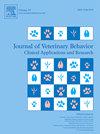The prevalence of behavior problems in dogs in the United States
IF 1.6
3区 农林科学
Q4 BEHAVIORAL SCIENCES
Journal of Veterinary Behavior-clinical Applications and Research
Pub Date : 2024-11-01
DOI:10.1016/j.jveb.2024.11.001
引用次数: 0
Abstract
Numerous studies have reported the prevalence of various behavior problems in dogs and cats around the world. The actual number of animals included in each varies but is typically less than 1000. The reported prevalence of the behavior problem also varies considerably. It was thought that data from 43,517 dogs enrolled in the Dog Aging Project (DAP), entered by their owners, might provide a more realistic picture of canine behavior problems in the United States. All behavior questions included in the DAP were taken from the C-BARQ and mini C-BARQ questionnaires and included four multi-question categories (i.e., aggression, separation and attachment behaviors, fear and anxiety behaviors, and housesoiling) and seven behaviors asked as single questions. Except for two yes/no questions, all were rated by the owner between 0 (no problem), 2 (moderate) and 4 (serious). Data was analyzed to determine the number of dogs showing moderate (2) to serious (4) levels of behavior appropriate for the question. Overall, 99.12% of dogs showed at least one problem of moderately serious (3) to serious (4) intensity or at least two problems of moderate to serious (2−4) intensity. Within the four multi-question categories, the prevalence of dogs showing moderate (2) to serious (4) behaviors at least twice with the category was 55.6% for aggression, 85.9% for separation and attachment behaviors, 49.9% for fear and anxiety behaviors, and 4.1% for housesoiling.
美国犬只行为问题的普遍程度
世界各地有大量研究报告了猫狗各种行为问题的发生率。每项研究涉及的实际动物数量各不相同,但一般都少于 1000 只。报告的行为问题发生率也有很大差异。我们认为,由主人填写的 43517 只狗参加 "狗老龄化项目"(DAP)的数据可能会更真实地反映美国犬类行为问题的情况。DAP 中包含的所有行为问题均来自 C-BARQ 和迷你 C-BARQ 问卷,其中包括四个多问题类别(即攻击行为、分离和依恋行为、恐惧和焦虑行为以及打滚)和七个单问题行为。除两个 "是/否 "问题外,所有问题均由主人评定,分值为 0(无问题)、2(中等)和 4(严重)。对数据进行了分析,以确定出现与问题相应的中度(2)至严重(4)行为的犬只数量。总体而言,99.12% 的狗至少表现出一个中等严重(3)至严重(4)程度的问题,或至少表现出两个中等至严重(2-4)程度的问题。在四个多问题类别中,狗至少两次出现中度(2)至严重(4)行为的比例分别为:攻击行为 55.6%、分离和依恋行为 85.9%、恐惧和焦虑行为 49.9%,以及打滚行为 4.1%。
本文章由计算机程序翻译,如有差异,请以英文原文为准。
求助全文
约1分钟内获得全文
求助全文
来源期刊
CiteScore
3.50
自引率
16.70%
发文量
107
审稿时长
325 days
期刊介绍:
Journal of Veterinary Behavior: Clinical Applications and Research is an international journal that focuses on all aspects of veterinary behavioral medicine, with a particular emphasis on clinical applications and research. Articles cover such topics as basic research involving normal signaling or social behaviors, welfare and/or housing issues, molecular or quantitative genetics, and applied behavioral issues (eg, working dogs) that may have implications for clinical interest or assessment.
JVEB is the official journal of the Australian Veterinary Behaviour Interest Group, the British Veterinary Behaviour Association, Gesellschaft fr Tierverhaltensmedizin und Therapie, the International Working Dog Breeding Association, the Pet Professional Guild, the Association Veterinaire Suisse pour la Medecine Comportementale, and The American Veterinary Society of Animal Behavior.

 求助内容:
求助内容: 应助结果提醒方式:
应助结果提醒方式:


